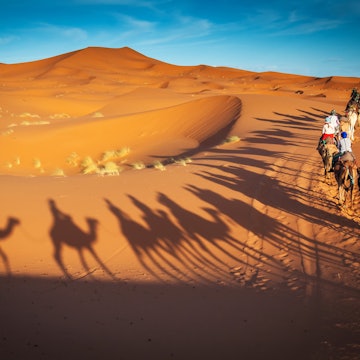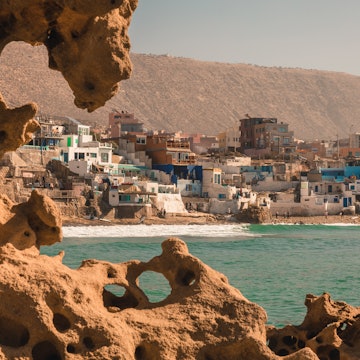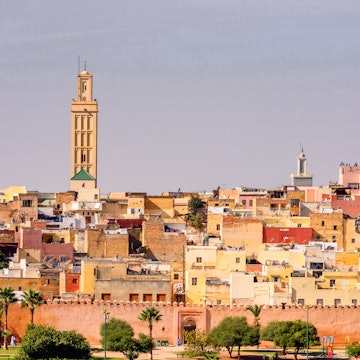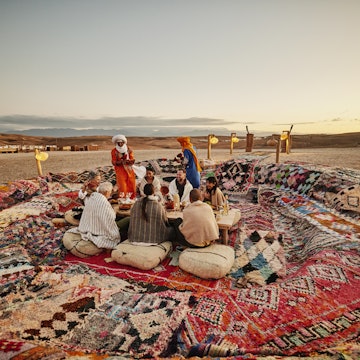
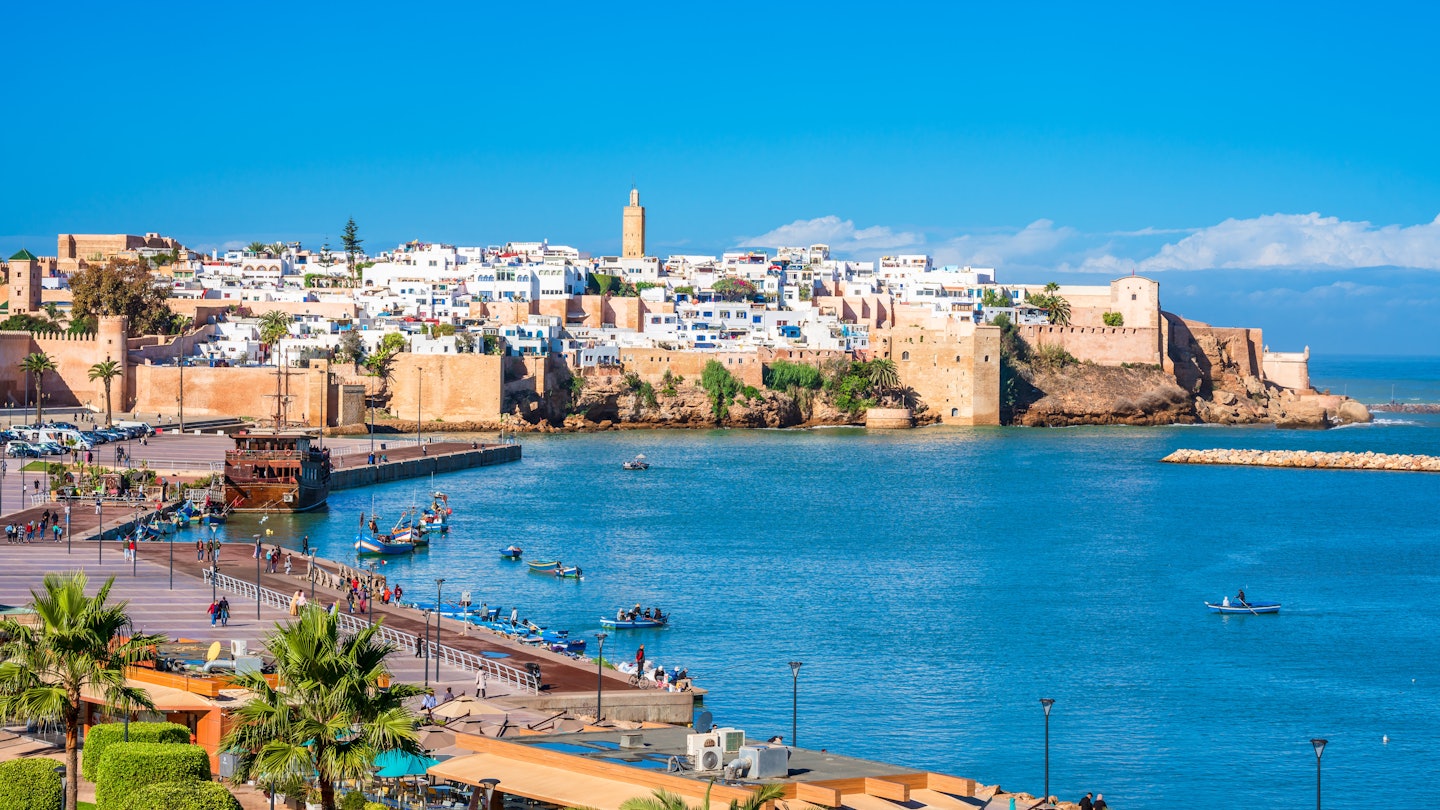
Rabat , Morocco. Sergio Formoso/Getty Images
Morocco’s pristine capital, Rabat is listed as a UNESCO World Heritage city for its blend of tradition and modernity, where a surprising number of historic sites sit comfortably within impressive modern urban planning.
It’s an enjoyable riverside city, with leafy avenues, manicured green spaces, striking architecture and a modern tramway linking walkable districts. The city caters to tourists as much as its friendly, open-minded population of 2 million, giving it an authentic, less touristy vibe than some other Moroccan cities.
Alongside beautifully preserved archaeological sites, there’s an easy-to-navigate medina and a thriving coastal-city culture with sandy beaches, cinemas, galleries, restaurants, festivals and shopping.
When should I go to Rabat?
Rabat is a year-round destination with a balmy Mediterranean climate. July and August are the hottest months with an average high of 28°C (82°F). However, due to the cooling Atlantic breeze even the hot days here are bearable. August is the busiest month for domestic tourism; you’ll find packed beaches, music festivals, and other outdoor events.
December to February are the coldest, wettest months with an average low of 8°C (46°F) at night and 17°C (63°F) during the day. Many international visitors travel to Rabat in the shoulder seasons, from March to June and September to November.

How much time should I spend in Rabat?
Rabat works well as a stand-alone city break. With a four-night itinerary, you can visit the highlights of Rabat, take a half-day trip to Hassan II Mosque in nearby Casablanca, and still have time to linger in a sunny cafe, by the pool, or have a hammam spa treatment.
If you’re visiting Rabat as part of a longer Morocco itinerary, two nights with a guide showing you the highlights is doable. Consider places unique to Rabat that you won’t experience elsewhere in Morocco, such as Kasbah des Oudaias, Mausoleum of Mohammed V and Chellah archaeological site.
Rabat also makes an excellent base for more extended stays; from the city, you can enjoy day trips to Casablanca, an hour by train or car, and Tangier, 1 hour 20 mins on the TGV fast train. Fez, Volubilis and Chefchaouen are also offered as day trips from Rabat; however, be prepared for 13-hour days.
Is it easy to get in and around Rabat?
Most international flights land in Casablanca, a one-hour taxi ride (Dh600/US$65 one way) from Rabat. You can also take the train directly from Casa’s airport terminal to Rabat city center. Check ONCF for timetables, a one-way ticket costs Dh28–65 (US$3–7).
Rabat-Salé Airport is for regional and domestic flights, and a taxi from there to the city center takes around 20 minutes and costs DH280 (US$30). An airport bus (DH28/US$3) operates to Rabat Ville station, check ALSA for the schedule.
Most neighborhoods are walkable, including the medina, Kasbah des Oudaias and Hassan district. Traveling between the districts in Rabat is easy on the city’s modern tramway (Dh6/US$0.65 per ride) and ticket machines are installed at each stop. Blue petits taxis are shared taxis that run based on a meter and can carry up to three passengers. For a private taxi, take a white grand taxi or ask your hotel if there is a recommended driver you should use.
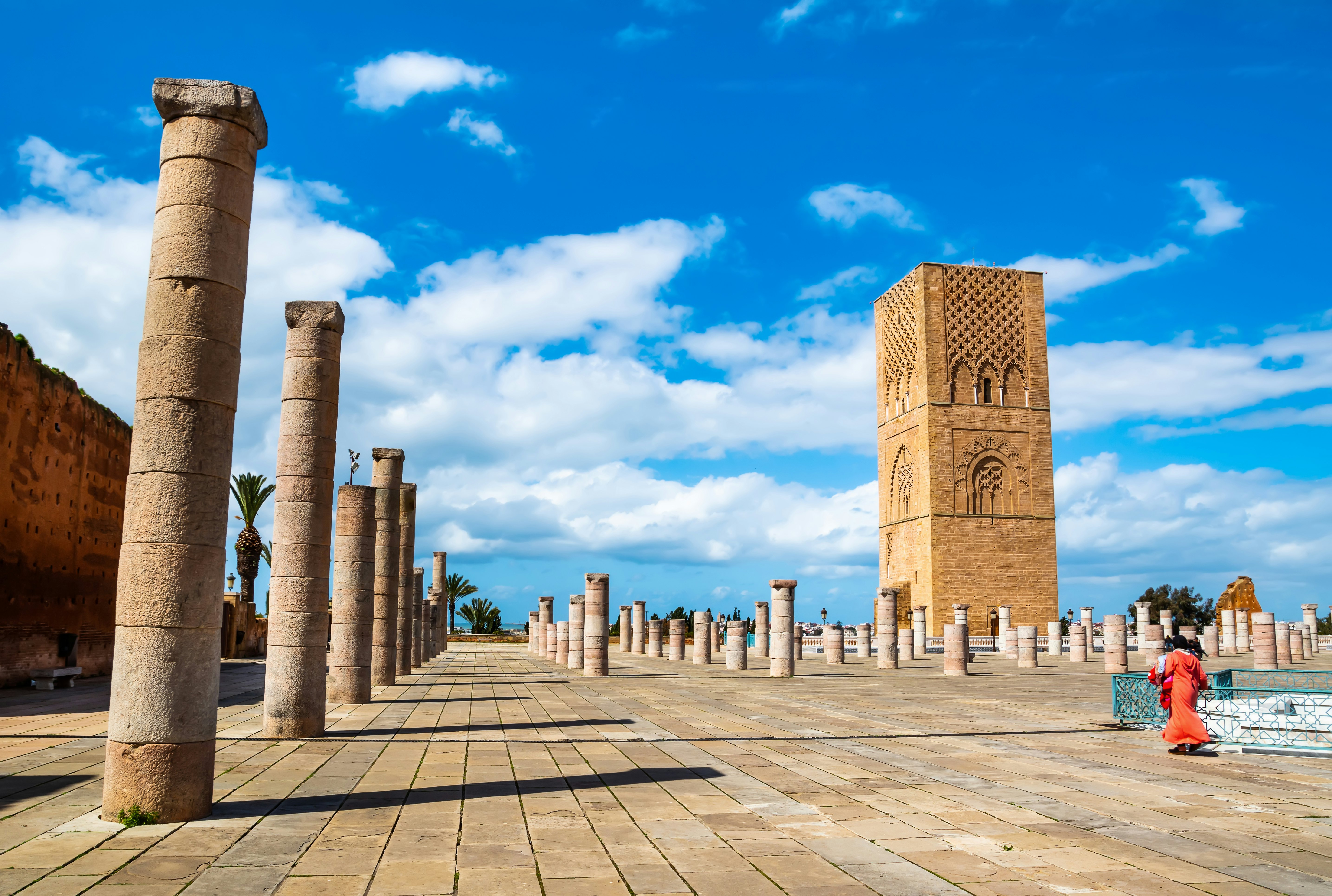
Top things to do in Rabat
Soak up the charm of Kasbah des Oudaias
This elevated 12th-century citadel has fantastic views over the River Bou Regreg and the Atlantic Ocean. Within the Kasbah’s medieval gates and rose-pink walls, you’ll find Rabat’s historic heart. Meander along cobbled streets and colorful alleys, marvel at the cobalt blue-and-white painted houses, and visit the citrus-scented Andalusian Gardens, a walled garden that's also home to the National Jewellery Museum. Next door, Café Maure offers fantastic river views and gateaux traditionelles biscuits made at home by the owner’s wife. A sunset visit to the Kasbah provides the best light and a chance to see the sun sink into the Atlantic.
Take a tour of tombs and the Royal Palace
Across from the Tour Hassan is the Mausoleum of Mohammed V, one of the city’s most iconic sites and a remarkable display of Islamic architecture. View the gold tombs of Mohammed V and his sons from a balcony in the mausoleum. Look up to take in the hand-carved cedarwood ceiling encrusted with gold.
To return your regal tour back to the present, head to the Royal Palace, the Moroccan royal family’s official residence. While the palace inside is closed to visitors, it’s possible to visit from the outside with a local guide. Passports are required.
Dig into Chellah’s archaeological ruins
Chellah is a sprawling necropolis and archaeological site, where you can see the remnants of the Roman and Merinid empires seamlessly interwoven. Roman roads, Latin inscriptions and mosaics meet with an Islamic minaret and mosque. Allow two hours for your visit. Ciconia, the on-site restaurant, has fantastic city views.

Admire Rabat's architecture
Rabat’s skyline is rapidly changing and best appreciated in a tour showcasing the art-deco style of the New City, which includes Rabat Ville train station, the Post Office and Musée Mohammed VI Art Moderne et Contemporain, among others. See contemporary architecture in the Zaha Hadid-designed Grand Théâtre de Rabat, with its sweeping futuristic lines, and the soon-to-open Mohammed VI Tower, Rabat-Salé’s tallest skyscraper at 250m (820ft).
Go shopping in the souks without the tourist crowds
Take a leisurely walk around the hassle-free streets of Rabat medina starting on Rue des Consuls. If you’re not in a hurry, follow the souks and see where you end up. Look out for bargains on antiques, carpets, cushion covers, brassware and secondhand books.
My favorite thing to do in Rabat
I love waking up in a traditional riad, spending a day exploring historic sites, and hitting the beach for a sunset surf at Oudaya. For dinner, I go to Matsuri, a Japanese restaurant in Souissi, Rabat’s leafy embassy district.

How much money do I need for Rabat?
Rabat is excellent value for money and is accessible for all travelers from budget to blowout. It is worth noting that the less expensive options, especially food and accommodations, are not always of lesser quality. Look out for lines of locals at street stalls and low-key restaurants serving Moroccan dishes; Moroccans know where to find a tagine or couscous and rarely pay tourist prices. That said, if you want to splurge, there are luxury offerings at five-star hotels, such as Four Seasons, that cater to discerning taste buds.
Cash is handy for tips and small purchases in the souk or hanut, local shops that sell water, snacks and phone credit. Some guesthouses, guides and cafes will ask for payment in cash. More and more places are accepting contactless including Apple Pay.
Here are some examples of average daily costs you could expect:
Double Room in a traditional riad: from Dh500/night (US$54)
Double Room in a 4-star central hotel: from Dh1200/night (US$130)
Single tram journey: Dh6 (US$0.65)
Americano in a local cafe: from Dh20 (US$2.15)
Maakouda sandwich at a street-stall: Dh5–15 (US$0.54–1.62)
Bottle of water (1.5 liters) in a local shop: from Dh7 (US$0.75)
Bottle of local beer Casablanca (33cl) in a bar: Dh65 (US$7)
Glass of wine in a restaurant: Dh65 (US$7)
Chicken tagine in a local restaurant: from Dh100 (US$10.80)
Three-course dinner (excluding drinks) in a four-star riad with an alcohol license: from Dh300 (US$32)

Is Rabat safe?
Due to the volume of diplomats and Royal residents, Rabat is a well-policed city. This high security presence is reassuring, however, take sensible precautions to avoid petty crime by keeping phones, wallets, and easy-to-grab valuables away from an opportunist’s eye.
Can you drink the tap water in Rabat?
It is advisable to drink filtered water – now offered by restaurants and hotels – or purchase bottled water.
Is alcohol available in Rabat?
Alcohol is available in licensed bars, restaurants, hotels, some European supermarkets and a handful of wine shops.
What’s the tipping culture?
Keep cash to hand for tipping. Wages are low in Morocco, so tips are greatly appreciated and have become a way to show gratitude and respect. As a rule, calculate 10–15% of the bill for cafes, restaurants and services, including porters and guides. There’s no set rule: go with what feels right and in line with the service you’ve received.
Which languages are spoken?
Moroccans are adept at speaking multiple languages. Rabat is predominantly Arabic- and French-speaking; however, nowadays, English is widely spoken in the tourism industry. Learning a few phrases in Moroccan Arabic will be well received and can deepen your understanding of the culture.
What should I wear in Rabat?
Rabat is a forward-thinking, modern city; it’s common to see people expressing themselves through style. However, when visiting religious and royal sites, dress respectfully, wear loose-fitting clothing that covers shoulders and knees, and keep a scarf to hand.
What's it like to visit Rabat during Ramadan and on Holy Days?
During Ramadan, Muslims fast from sunrise to sunset, and many cafes and restaurants close during the day, opening an hour or so before sunset. Tourist-centric hotels and riads operate (almost) as usual; staff may take a break around sunset to break the fast. Every Friday is a Holy Day; most places close around midday for the weekly Mosque prayers. Afterwards, the tradition is to share a couscous lunch with family at home or in a restaurant; you can join locals for couscous in the medina.









